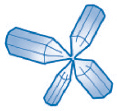It's Raining Fish and Spiders (20 page)
Read It's Raining Fish and Spiders Online
Authors: Bill Evans

Sometimes capped columns form with a twist, a 30-degree twist to be specific. The two end-plates are both six-branched crystals, but one is rotated 30 degrees relative to the other. This is a form of crystal twinning, in which two crystals grow joined in a specific orientation.

Bullet Rosettes

Sometimes a bullet rosette can become a capped rosette, as shown in the example in the middle.
Â
The nucleation of an ice grain sometimes yields multiple linked crystals that grow together at random orientations. When the different pieces grow into columns, the result is called a bullet rosette. These polycrystals often break up into isolated bullet-shaped crystals.

Radiating Dendrites

The far example on the right shows radiating plates. The other example shows a fernlike stellar dendrite with two errant branches growing up out of the main plane of the crystal.
Â
When the pieces of a polycrystal grow out into dendrites, the result is called a radiating dendrite or a spatial dendrite.

Rimed Crystals

The first two pictures at the right have relatively light rime coverage. The final example is completely covered with rime, but you can still see the six-fold symmetry of the underlying stellar crystal.
Â
Clouds are made of countless water droplets, and sometimes these droplets collide with and stick to snow crystals. The frozen droplets are called rime. All the different types of snow crystals can be found decorated with rime. When the coverage is especially heavy, so that the assembly looks like a tiny snowball, the result is called graupel.

Irregular Crystals

The most common snow crystals by far are the irregular crystals. These are small, usually clumped together, and show little of the symmetry seen in stellar or columnar crystals.
Artificial Snow

You can see from the picture at the right that artificial snow is made of frozen water droplets, with none of the elaborate structure found in real snow crystals.
Â
Snowmaking machines shoot a mixture of water and compressed air out of nozzles. The water comes out as fine droplets, and the air cools as it decompresses, causing the droplets to freeze. A fan blows the ice particles onto the slopes.

Man-made snow may look like real snow, but look at the difference between it and the real thing. Because the ice crystals of man-made snow are not born in the very cold reaches of Earth's atmosphere, they do not get to form into beautiful flakes. It's great to ski on, but it's certainly not as pretty as the real thing!
Tracking a Snowstorm
One of the most frequent questions I am asked by students is, “How do you know when a snowstorm is coming?” Let's take a look at a storm as it develops and track it across the country.
Most big snowstorms need just two things to really make a lot of snow. They need lots of moisture and lots of cold, preferably arctic, air. It's common for a low to develop over the Central Plains and head southeastward. Let's position that low in Texas near Dallas on a Monday at 12
P.M
. It is heading east, through the southeastern United States. High pressureâour preferred arctic air massâis sitting over the Great Lakes and sinking south from Canada.

